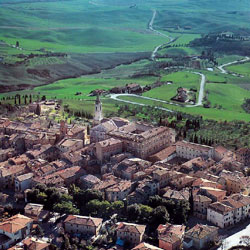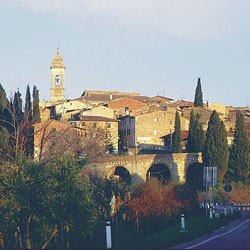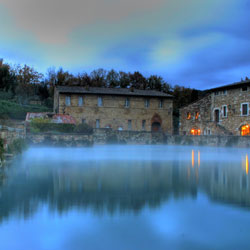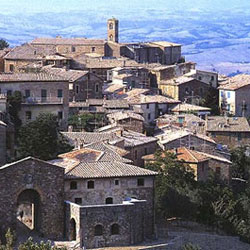Tuscany Tours
Siena, San Gimignano, Monteriggioni | Arezzo, Montepulciano, Cortona | Pienza, San Quirico D'Orcia, Bagno Vignoni, Montalcino | The Chianti Area | Volterra, Pisa and Lucca
Pienza, San Quirico D'Orcia, Bagno Vignoni, Montalcino
Suggested tour of 1-or-2 day’s from Rome with the visit of Pienza, San Quirico D’Orcia, Bagno Vignoni and Montalcino, the service is driver/guided and is individually personalized.
Siena, San Gimignano, Monteriggioni | Arezzo, Montepulciano, Cortona | Pienza, San Quirico D'Orcia, Bagno Vignoni, Montalcino | The Chianti Area | Volterra, Pisa and Lucca
Pienza, San Quirico D'Orcia, Bagno Vignoni, Montalcino
Suggested tour of 1-or-2 day’s from Rome with the visit of Pienza, San Quirico D’Orcia, Bagno Vignoni and Montalcino, the service is driver/guided and is individually personalized.
| Pienza. The tour will start from your hotel and we will drive north of Rome through three of the most beautiful Italian regions Lazio, Umbria and Tuscany. Pienza is situated on the Via Cassia, just a few kilometers from Cianciano Terme, one finds Pienza. Like Castiglione d'Orcia, Montalcino, Radicofoni and San Quirico d'Orcia the city is part of the Val d'Orcia. Pienza is known for its historical ties with Enea Silvio Piccolomini, who became Pope Pio II in 1458 and transformed Pienza from a small Medieval village into an elegant Papal residence with architecture typical of the Renaissance period. Even the shortest of visits to Pienza should include a walk along the town walls and an exploration of the historic center, with its perfectly preserved Renaissance buildings, such as Palazzo del Tesoriere, Palazzo Lolli, the Cathedral of the Assunta, Palazzo Piccolomini, Palazzo Borgia and Joffroy, Palazzo Comunale, Palazzo Ammanati, the Parish Church of Corsignano. Local delicacies include the Cacio pecorino cheese which can be tasted and bought in almost all of the shops in the town. |
 |
| San Quirico d'Orcia. San Quirico d'Orcia is situated atop a hill within the Valdorcia Nature Park, in an area of Tuscany which comprises the towns of Bagno Vignoni, Montalcino, Pienza, and Montepulciano. The origins of this ancient town date back to the Etruscan period. Around about the year 1000, San Quirico established itself as important town on the via Franchigena, the road linking Canterbury with Rome. It was in San Quirico d'Orcia that Fredrick I the 1st met with the pontifical authorities after his arrival in Italy to receive the imperial crown in 1154. In 1552 the troops faithful to Charles V chose San Quirico d'Orcia as military outpost from where to control the entire valley. An imposing perimeter wall protects the town, accessed by a gateway, the only of the four original gateways to have survived the passage of time. The historic center of San Quirico perfectly conserves its medieval plan and a great number of impressive works of architecture such as the Romanesque Church of the Collegiata, with its three portals one of which attributed to Giovanni Pisano; the 17th century Palazzo Chigi; the Church of San Francesco which houses a Madonna by Andrea della Robbia; the Horti Leonini, splendid example of late 16th century landscape gardening; the intimate Romanesque Church of Santa Maria dell'Assunta and the Ospedale della Scala, once the refuge of pilgrims travelling along the via Franchigena. |
 |
| Bagno Vignoni. Bagno Vignoni is a small village in the heart of the Valdorcia, a village where time seems to have stood still for centuries. Situated on the Via Franchigena, the historic pilgrim route leading to Rome, Bagno Vignoni centres around a large pool of thermal water. Bordered by a 14th century wall, the pool is continually replenished with warm water (52°) from the village's thermal springs. The health inducing properties of the water have been known since ancient times. Today, the waters are used in spa therapies performed in the various wellness centers situated in Bagno Vignoni. Many of the medieval houses and palazzi of Bagno Vignoni have been transformed in attractive bars, restaurants, and shops. The buildings overlooking three sides of the central pool are particularly charming, A typical loggia supported by pillars in travertine marble closes the fourth side of the baths. Legend has it that Saint Catherine, after whom the loggia takes its name, used to bathe in these waters, as did members of all the great noble families of Siena. On cold winter nights, the contrast between the external temperature and that of the warm thermal waters produces vapours which rise up from the pool and envelop the whole of Bagno Vignoni. The resulting magical, almost surreal atmosphere, was immortalised in the Russian director Andrej Tarkóvskij's film, "Nostalgia". |
 |
| Montalcino. A center which could be defined as being immersed in a natural treasure trove made of enchanting landscapes similar to those found in the paintings of the 1300s. The long lines of vines have assigned Montalcino a prestigious position amongst Italian wine producers. The fabulous Brunello and Rosso di Montalcino are exported throughout the world and considered to be amongst the very best Italian wines. Montalcino represents a wealth of history with its unchanged Medieval appearance: the Castle of Artigiano, the Castle Poggio alle Mura, the Romitorio Fortress and the Church of St Resituita, not to mention the Nearby Abbey of St Antimo. Culture and art are present in the United Museums which combine the Civic Museum and Diocesan Museum where one finds a host of frescos from the Siennese school of the XII and XIV centuries. Visitors can also experience the popular festivals which represent historical traditions, such as the tournament for the opening of the hunting season, or the Festival of the Thrush, a spectacular event with processions, period costume and local gastronomy. |
 |